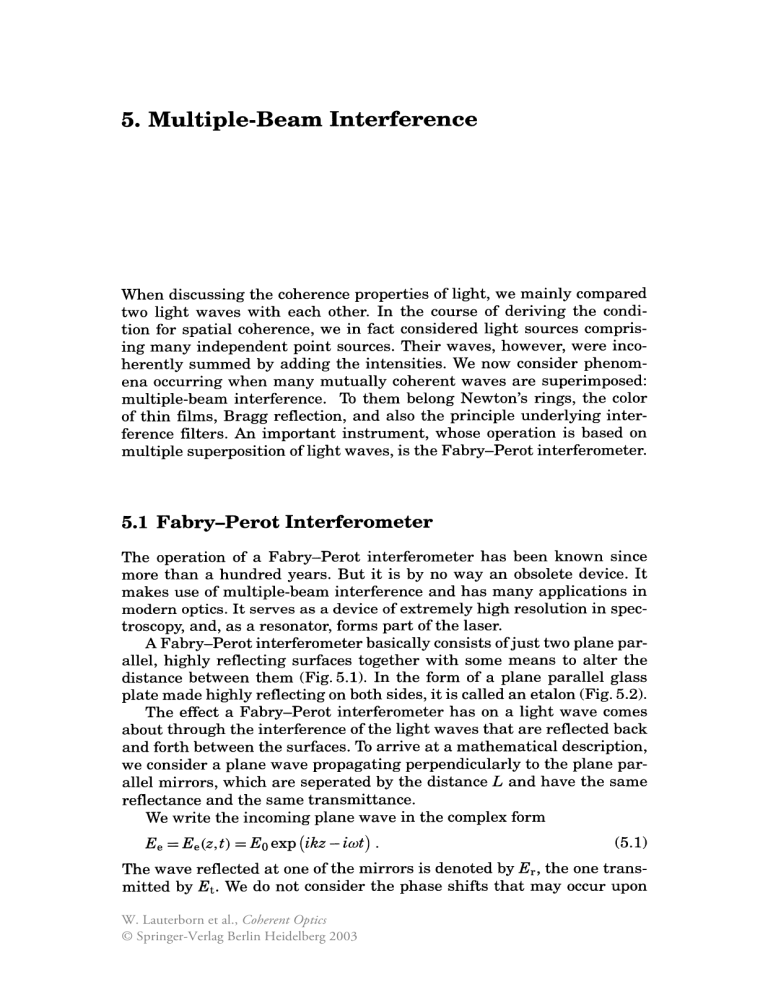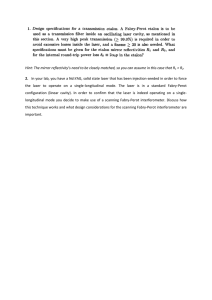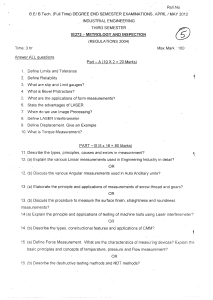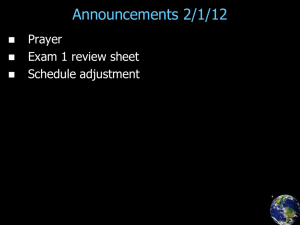
5. Multiple-Beam Interference When discussing the coherence properties of light, we mainly compared two light waves with each other. In the course of deriving the condition for spatial coherence, we in fact considered light sources comprising many independent point sources. Their waves, however, were incoherently summed by adding the intensities. We now consider phenomena occurring when many mutually coherent waves are superimposed: multiple-beam interference. To them belong Newton's rings, the color of thin films, Bragg reflection, and also the principle underlying interference filters. An important instrument, whose operation is based on multiple superposition oflight waves, is the Fabry-Perot interferometer. 5.1 Fabry-Perot Interferometer The operation of a Fabry-Perot interferometer has been known since more than a hundred years. But it is by no wayan obsolete device. It makes use of multiple-beam interference and has many applications in modern optics. It serves as a device of extremely high resolution in spectroscopy, and, as a resonator, forms part of the laser. A Fabry-Perot interferometer basically consists of just two plane parallel, highly reflecting surfaces together with some means to alter the distance between them (Fig. 5.1). In the form of a plane parallel glass plate made highly reflecting on both sides, it is called an etalon (Fig. 5.2). The effect a Fabry-Perot interferometer has on a light wave comes about through the interference ofthe light waves that are reflected back and forth between the surfaces. To arrive at a mathematical description, we consider a plane wave propagating perpendicularly to the plane parallel mirrors, which are seperated by the distance L and have the same reflectance and the same transmittance. We write the incoming plane wave in the complex form Ee = Ee(z,t) = Eo exp (ikz - iwt) . (5.1) The wave reflected at one of the mirrors is denoted by E r , the one transmitted by E t . We do not consider the phase shifts that may occur upon W. Lauterborn et al., Coherent Optics © Springer-Verlag Berlin Heidelberg 2003 62 5. Multiple-Beam Interference adjustable :..... ..:- .... - ___ light mirror --- 4 +reflecting layers + lens screen Fig. 5.1. Fabry-Perot interferometer. reflection and transmission. They do not alter the principle of operation of the instrument. Then, the amplitude reflectance r and the amplitude transmittance t, defined by Er Et and t = - , (5.2) Ee Ee are real numbers between zero and one. Moreover, we suppose that the mirrors are nonabsorptive. Then, by the law of conservation of energy, the following relation holds: r=- (5.3) With these assumptions, the electric field amplitude immediately behind the left mirror (see Fig. 5.3) after the incoming wave Ee has passed the first mirror is E t = tEe(O,t) = tEeO' After passage of the light through the second mirror we have: El = tEt exp (ikL) = Eeot2 exp (ikL) . (5.4) Because of the optical path length L between the mirrors a phase factor exp (ikL) is introduced. Part of the wave E t exp (ikL) incident on the • light • ! ! T reflecting T layers Fig. 5.2. Etalon. 5.1 Fabry-Perot Interferometer first mirror second mirror z=o z=L 63 El=Eeat2exp(ikL) E 2=Eeot2r2exp(3ikL) E 3=Eeot2r4exp( 5ikL) .. I L Fig. 5.3. Light waves in a Fabry-Perot interferometer. second mirror is reflected, giving a wave E 1r = trEeoexp (ikL) traveling back to the first mirror. After additional reflection at the first mirror and passage through the second mirror, the amplitude E2 = EeOt2r2 exp (ik3L) (5.5) is obtained. The output wave now has suffered two transmissions (t 2 ) and two reflections (r2) and has experienced an additional phase shift k3L because of the path length 3L. From (5.4) and (5.5) the law for the partial waves being transmitted can immediately be derived. After each round trip the wave amplitude has to be multiplied by r2 exp (ik2L), giving E n =En_1r 2exp(ik2L), n=2,3, ... , (5.6) or, explicitly written: En = Eeot2 exp (ikL) r 2(n-l) exp [ik2(n - l)L] . (5.7) As we have assumed a plane wave, the partial waves E 1 , E 2, E3, ... superimpose behind the second mirror to yield the output wave amplitude Et : oc oc E t = LEn = Eeot2 exp (ikL) Lr2(n-l) exp [ik2(n -l)L] n=l n=l oc = Eeot2exp (ikL) Lr2n exp (ik2nL) oc = Eeot2exp (ikL) L[r2exp (ik2L)]n. n=O (5.8) 64 5. Multiple-Beam Interference The sum is a geometric series that can be expressed in closed form: 00 1 "qn - _ -l-q Iql< 1. for (5.9) n=O Therefore, with q = r2 exp (ik2L) , (5.10) the output amplitude of the instrument is E t = Eeo t2 exp (ikL) 2 1 ("k L) . 1-rexpl2 (5.11) As always, we are able to see or measure only the intensity. To simplify the notation, we introduce the phase shift 0 for one round trip between the mirrors: (5.12) 0=k2L. We then get for the output intensity: It = E E* = E E* t4 t t eO eO 1 (1- r2 exp[ioD(1- r2 exp[ -ioD 1 4 = let 1 + r 4 _ r2 exp[ -io] - r2 exp[io] 1 4 (5.13) = let 1 +r4 - 2r2coso' where Ie = EeE; = EeoE;O is the input intensity entering the instrument. This expression is usually given a different form. With the relation cos 0 = 1- 2sin 2(0/2) we obtain: It = let = let 1 4 2 1 +r4 - 2r 2(1- 2sin (0/2» 4 1 2. (1- r2)2 + 4r2 sin (0/2) (5.14) Now, recalling that r2 + t 2 = 1 leads to: Ie 2 1+(2r/(1-r2»2 sin (0/2) Ie Ie 2 - 1+Ksin (0/2) - 1+Ksin2kL· It = (5.15) The quantity ) K- (1-r 2 2 is called finesse coefficient. (5.16) 5.1 Fabry-Perot Interferometer 65 0.5 o ... (n-1) 11: kL (n+1) 11: ... n1l: Fig. 5.4. The Airy function for different amplitude reflectances r. The intensity transmittance T[ of the Fabry-Perot interferometer, consisting of two mirrors a distance L apart, thus is given by It 1 T[- Ie - 1+Ksin2 kL' (5.17) This function is called the Airy function (Fig. 5.1). We observe that the function is periodic both in L and in k. For instance, if we keep L fixed and alter the wave number k = 211:/)... or the wavelength)..., then we periodically observe the same intensity transmittance. In particular, because of the roots of the sine function we periodically obtain a transmission of unity, that is, complete transmission for certain wavelengths or frequencies. Therefore the instrument is wavelength selective (frequency selective) and represents an optical filter. Because of the periodicity of the transmitting regions it is a comb filter. The complete transmission through both mirrors, when the distance between them is n . )",/2, is highly surprising in view of the high reflectivity of each mirror, 99.9% say. Figure 5.5 demonstrates this peculiar behavior with two experimental arrangements. If just one mirror with a reflectance of 99.9% is placed in front of the detector, then only 0.1% of the incoming light reaches the detector. When a second mirror, again of 99.9% reflectance, is placed in between at a distance of n . ).../2 from the ). I P- mirror detector reflectivity light .. 99.9% 0.1% ). .. ----- 99.9% 99.9% reflectivity Pdetector 100% light Fig. 5.5. Arrangement for demonstrating the reflection properties of one and of two mirrors. 66 5. Multiple-Beam Interference first one, then not 0.1% ofthe 0.1% transmitted in the first arrangement is measured, but a full 100% ofthe incident light is detected, as if neither mirror were present. The actual action as a mirror depends on the experimental arrangement. Thus, an absolute value of reflectance cannot be ascribed to a mirror. A mirror can alter its reflection properties without being altered itself! Figure 5.1 shows the dependence of the Airy function on the quantity kL for different amplitude reflectances r. For values of r near unity, sharp transmission regions are obtained. The distance between the maxima is of practical importance. The wavelength where complete transmission is observed is not unique, because every wavelength An that obeys the equation 2JT nJT =knL=-L An n integer, or (5.18) is completely transmitted. Thus, only the wavelength region between two successive maxima is of interest. This distance is usually given as a frequency difference Ll v and is called the free spectral range (FSR). Its size may be obtained in the following way. Two adjacent maxima of transmission at wave numbers k n and kn+l obey the relation (5.18) for the integers nand n + 1, respectively. Subtracting both equations leads to JT 2JT Llv c = (kn+l -kn)L = LlkL = - - L , where additionally Llv = (c/2JT)Llk has been used. Thus, the free spectral range is given by c (5.19) Llv=2L' Two frequencies whose separation is smaller than Ll v can be distinguished unambiguously (within the resolving power ofthe instrument). The absolute wavelengths must be determined otherwise, at least to an accuracy of a free spectral range. A second characteristic number of a Fabry-Perot interferometer is its finesse F. It indicates how many spectral lines are resolvable within a free spectral range, and is defined as F = Llv , lih (5.20) Ll v being the free spectral range and lih the width at half maximum of the Airy function peaks (see Fig. 5.1). The width lih is defined as the full frequency width of a region, where the intensity transmittance T is larger than 1/2. As can be seen by the example with r = 0.2 in Fig. 5.1, lih and therefore also the finesse F are defined for sufficiently large r only. But just these cases are of interest. 5.1 Fabry-Perot Interferometer 67 The width tih depends on the parameters rand L of the interferometer in the following way. A wave number kh is introduced by khL = 2rrvh L = rrtih L, (5.21) c c where 2vh = tih; vh is the frequency width from the maximum to the half maximum. Then, from (5.17), we have (Th = half offull transmission =112) T h =! = 2 1 1 + K sin2 khL . (5.22) For this relation to be valid requires K sin2 khL = 1 . For r;$ 1 the transmission regions are small and therefore khL is also small. Then, sin(khL) can be replaced by khL, and we get K(khL)2 = 1 or khL = JK . Together with (5.21) we have k' L = rr tih L = h C (5.23) ../K or c c(l-r2) --=-::- rrL../K - rrL2r . tih - - - - - (5.24) This is the desired relation for tih. Then, using the definition (5.20) together with (5.19) and (5.24), we can express the finesse F by F = L1v = tih crrL2r 2Lc(l- r2) = 1- r2 . (5.25) From this equation it follows that the number of resolvable spectral lines depends solely on the reflectance r of the mirrors; the larger it is, the higher the reflectance. A Fabry-Perot interferometer with F = 100 already is a good instrument; F = 10000 is possible at present and is commercially available. A further important quantity is the resolving power A. As with every spectral instrument, it is defined by v (5.26) A=-, tih v being the (mean) frequency and Vh the full width at half maximum of a single transmission region, also called the instrumentallinewidth. From the definitionF = L1v/tih we have (5.27) 68 5. Multiple-Beam Interference and thus obtain for the resolving power of a Fabry-Perot interferometer: A= . (5.28) L1v With this simple instrument, composed ofjust two plane parallel mirrors, astonishing values for the resolving power are attainable. A typical value for A is 108 ! A comparison with a grating spectrometer puts this figure into perspective. A grating with 1000 lines gives a resolving power of only 103 in the first diffraction order. However, the free spectral range of a Fabry-Perot interferometer is much smaller than that of a grating spectrometer. 5.2 Mode Spectrum of a Laser A laser consists of several parts, one being a resonator to feed back part of the generated light into the amplifying medium. In the simplest case, the resonator consists of two plane parallel mirrors at a distance L. Without the laser material in between this is just the Fabry-Perot arrangement. The reflectance, however, is usually different for both mirrors, near 100% for the first One and significantly less for the second one, the output mirror (about 96% for a He-Ne laser). A resonator of this kind has a longitudinal mode spectrum similar to the line spectrum of a Fabry-Perot instrument. The spectral width of a laser line usually comprises several longitudinal modes of the laser resonator. Those modes that are sufficiently amplified by the laser medium are generated and radiated (Fig. 5.2). fluorescence curve (amplification curve) V / r- 1\ resonator modes I\. "- laser threshold frequency v Fig. 5.6. The formation of the spectrum of laser light. Thus, laser light gets its properties by multiple-beam interference. Several methods are available for measuring the mode spectrum of a laser. We put forward two of them: interference spectroscopy and difference-frequency analysis with fast photodiodes. 5.2 Mode Spectrum of a Laser 69 5.2.1 Interference Spectroscopy When high resolving powers are needed in optics, it is usually the FabryPerot interferometer that is used. It is best suited for the determination of the mode spectrum of a laser. The arrangement is as follows (Fig. 5.7). The laser light is made slightly divergent by a lens, L1. and enters the -- .... -- .... -- ... - ...... - laser lens Ll mirror Ml mirror lens M2 L2 screen Fig. 5.7. Arrangement for the determination oflaser modes with a Fabry-Perot interferometer. Fabry-Perot interferometer, where the light is reflected back and forth between the two mirrors M1 and M 2 . The output light is collected by a lens, L 2 , and directed onto a screen located in the back focal plane of the lens L 2 . Thereby, all rays leaving the interferometer at the same angle are collected in one point. Why do we need lens L1? Most lasers have an extremely small angle of divergence. It then becomes difficult to adjust the instrument to let even one laser mode pass the instrument. However, when we produce a set of oblique rays with lens Ll, different path lengths become available. At an angle of incidence a (Fig. 5.2.1) we have: L La = - - . (5.29) cosa If the angle a = aFSR is such that L cosaFSR 2 )J2 FSR L Fig. 5.8. Ring formation at the output of a Fabry-Perot interferometer. 70 5. Multiple-Beam Interference Fig. 5.9. Fabry-Perot ring system with five modes of a 15 m W He-N e laser. then the same wavelength 'A is transmitted again. A particular wavelength 'A from a divergent light beam thus leaves the instrument at discrete angles, for instance, at a = ao, ao +aFSR, .... Because of the rotational symmetry a ring system is obtained on the screen. If the divergent beam contains not just one but several modes, then each of them leads to a separate concentric ring system, a A,a A+aFSR, . .. , shifted by an angle a A according to the wavelength (Fig. 5.9). The meaning of the free spectral range Llv (or Ll'A, or Lla) is immediately detectable in the ring system. The separation of spectral lines can be determined only within a free spectral range. It is even necessary to know beforehand that the separation is smaller than the free spectral range to arrive at the correct value. The free spectral range can be altered by adjusting the mirror separation L. A smaller L leads to a larger Llv . Absolute wavelengths normally cannot be measured with a Fabry-Perot interferometer. Instead, it is very well suited for measuring difference frequencies, such as the splitting of spectral lines and differences oflaser modes (Fig. 5.9) down to the MHz region. There, electronic devices take over for lower frequencies. A different solution for observing laser modes is depicted in Fig. 5.10: the scanning Fabry-Perot interferometer. The light propagating along laser Fabry-Perot detector oscilloscope Fig. 5.10. Principle ofthe scanning Fabry-Perot interferometer. 5.2 Mode Spectrum of a Laser 71 the optical axis of a Fabry-Perot interferometer is collected and directed onto a photodiode. To shift different wavelengths into the transmission region, the length L between the mirrors is altered, usually piezoelectrically, and the photodiode signal (y-axis) is plotted versus the mirror separation (x-axis) on an oscilloscope. If the wavelength of the incident light is ).., then transmission is obtained at mirror separations of ... , (n - 1) . )"/2,n' ),, / 2, (n + 1) . )../2, .... Again there is ambiguity because of the finite free spectral range according to ,1L = )../2 (Fig. 5.11). Ifmore lines are present, they are transmitted at the corresponding lengths L A and form additional signals on the oscilloscope. Figure 5.12 shows three photographs taken from an oscilloscope screen. Three different He-Ne lasers with two, three, and five longitudinal modes have been analysed. 0 0 .. . (n-1) ')J2 r a.",.mit OO 0 0 n ')J2 (n+1) ')J2 FSR • L • L mirror separation Fig. 5.11. Sketch of signals obtained with a scanning Fabry-Perot interferometer on an oscilloscope for light of one wavelength only (above) and for a laser with three modes (below). The repetition of the signal groups appears because the length L is varied over more than one free spectral range. Fig. 5.12. Photographs from an oscilloscope screen showing the mode spectrum of three different He-Ne lasers with two, three, and five modes, respectively.



